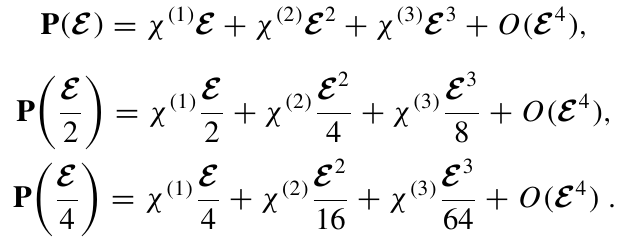Two-photon absorption: Difference between revisions
| Line 42: | Line 42: | ||
[[File:Extrapolation.png|center|350px| extrapolation]] | [[File:Extrapolation.png|center|350px| extrapolation]] | ||
for more detail see Ref.<ref name=tpa></ref>. Hereafter the | for more detail see Ref.<ref name=tpa></ref>. Hereafter the inputs for the real-time simulation that can be generated using the command <code>yambo -u n</code>: | ||
nloptics # [R] Non-linear spectroscopy | |||
% NLBands | |||
<span color="red"> 1 | 7 | </span> # [NL] Bands range | |||
% | |||
NLverbosity= "low" # [NL] Verbosity level (low | high) | |||
NLtime=74.000000 fs # [NL] Simulation Time | |||
NLstep= 0.002500 fs # [NL] Time step length | |||
NLintegrator= "INVINT" # [NL] Integrator ("EULEREXP/RK2/RK4/RK2EXP/HEUN/INVINT/CRANKNIC") | |||
NLCorrelation= "IPA" # [NL] Correlation ("IPA/HARTREE/TDDFT/LRC/LRW/JGM/SEX") | |||
NLLrcAlpha= 0.000000 # [NL] Long Range Correction | |||
% NLEnRange | |||
0.200000 | 5.000000 | eV # [NL] Energy range | |||
% | |||
NLEnSteps= 481 # [NL] Energy steps | |||
NLDamping= 0.100000 eV # [NL] Damping (or dephasing) | |||
#EvalCurrent # [NL] Evaluate the current | |||
% Field1_Dir | |||
1.000000 | 0.000000 | 0.000000 | # [NL Field1] Field Versor | |||
% | |||
Field1_kind= "SIN" # [NL Field1] Kind(SIN|SOFTSIN|RES|ANTIRES|GAUSS|DELTA|QSSIN) | |||
% GfnQP_E | |||
0.600000 | 1.000000 | 1.000000 | # [EXTQP G] E parameters (c/v) eV|adim|adim | |||
% | |||
Field1_Int=4.0000E+4 kWLm2 # [NL Field1] Intensity | |||
Field1_Tstart= 0.000000 fs # [NL Field1] Initial Time | |||
== Use Richardson extrapolation to extract the TPA == | == Use Richardson extrapolation to extract the TPA == | ||
== References == | == References == | ||
Revision as of 19:13, 26 March 2024
In this tutorial we will show how to calculate two-photon absorption(TPA) in bulk silicon, following the approach descried in Ref. [1].
In this tutorial we suppose you are already familiar with the non-linear response using the Yambo code.
If it is not the case please study the previous tutorials: Linear response using Dynamical Berry Phase and Real time approach to non-linear response (SHG).
The tutorial is divided in different steps from the DFT calculation to the final TPA spectrum. For the calculation of the TPA we will use the real-time approach proposed in Ref. [2]
DFT calculations
Here we provide input files for QuantumEspresso both the self-consistent calculation and the non-self-consistent: QE_silicon.tgz
Run them, import the wave-function in Yambo and run the setup. (see previous tutorials).
Removing symmetries
In this tutorial we will calculate the TPA along the 'x' direction therefore we remove symmetries not compatible with an external field along this direction, with the command ypp_nl -y:
fixsyms # [R] Remove symmetries not consistent with an external perturbation % Efield1 1.000000 | 0.000000 | 0.000000 | # First external Electric Field % % Efield2 0.000000 | 0.000000 | 0.000000 | # Additional external Electric Field % BField= 0.000000 T # [MAG] Magnetic field modulus Bpsi= 0.000000 deg # [MAG] Magnetic field psi angle [degree] Btheta= 0.000000 deg # [MAG] Magnetic field theta angle [degree] #RmAllSymm # Remove all symmetries RmTimeRev # Remove Time Reversal #RmSpaceInv # Remove Spatial Inversion
the you can go in the FixSymm folder and run the setup again.
Calculations at different field intensities
In order to extract the TPA coefficient we will run a series of simulation at different intensities of the external field: Ε, Ε/2, Ε/4. The polarization obtained from these simulation can be expanded in the field as:
then we will combine them to obtain the TPA coefficient as:
for more detail see Ref.[1]. Hereafter the inputs for the real-time simulation that can be generated using the command yambo -u n:
nloptics # [R] Non-linear spectroscopy
% NLBands 1 | 7 | # [NL] Bands range % NLverbosity= "low" # [NL] Verbosity level (low | high) NLtime=74.000000 fs # [NL] Simulation Time NLstep= 0.002500 fs # [NL] Time step length NLintegrator= "INVINT" # [NL] Integrator ("EULEREXP/RK2/RK4/RK2EXP/HEUN/INVINT/CRANKNIC") NLCorrelation= "IPA" # [NL] Correlation ("IPA/HARTREE/TDDFT/LRC/LRW/JGM/SEX") NLLrcAlpha= 0.000000 # [NL] Long Range Correction % NLEnRange
0.200000 | 5.000000 | eV # [NL] Energy range
% NLEnSteps= 481 # [NL] Energy steps NLDamping= 0.100000 eV # [NL] Damping (or dephasing)
- EvalCurrent # [NL] Evaluate the current
% Field1_Dir
1.000000 | 0.000000 | 0.000000 | # [NL Field1] Field Versor
% Field1_kind= "SIN" # [NL Field1] Kind(SIN|SOFTSIN|RES|ANTIRES|GAUSS|DELTA|QSSIN) % GfnQP_E
0.600000 | 1.000000 | 1.000000 | # [EXTQP G] E parameters (c/v) eV|adim|adim
% Field1_Int=4.0000E+4 kWLm2 # [NL Field1] Intensity Field1_Tstart= 0.000000 fs # [NL Field1] Initial Time
Use Richardson extrapolation to extract the TPA
References
- ↑ 1.0 1.1 Two-photon absorption in two-dimensional materials: The case of hexagonal boron nitride Claudio Attaccalite, Myrta Grüning, Hakim Amara, Sylvain Latil, and François Ducastelle Phys. Rev. B 98, 165126 (2018)
- ↑ Nonlinear optics from an ab initio approach by means of the dynamical Berry phase: Application to second- and third-harmonic generation in semiconductors, C. Attaccalite and M. Grüning, Phys. Rev. B 88, 235113(2013)

